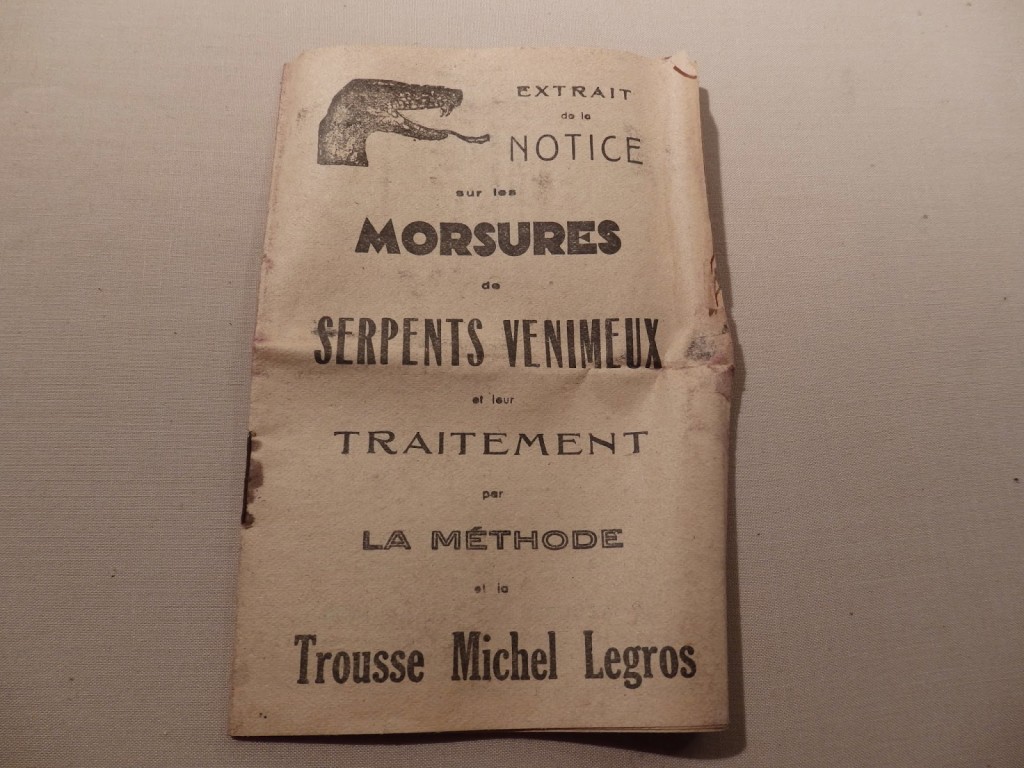“Treatment of bites from venomous snakes and scorpion stings
for all humans and animals.”
for all humans and animals.”
Here is an item I came across the other day and I thought
that if I don’t take a picture of it, I’m never going to see one again. It is a small “Do it yourself” anti-venom
kit to be carried by people spending time in the outdoors. I read on an old auction listing that it was
marketed towards hunters and fishermen in temperate areas of Europe where snakes
are more common.
that if I don’t take a picture of it, I’m never going to see one again. It is a small “Do it yourself” anti-venom
kit to be carried by people spending time in the outdoors. I read on an old auction listing that it was
marketed towards hunters and fishermen in temperate areas of Europe where snakes
are more common.
Michel Legros, a French pharmacist from Limoges in the
Limousin region, invented it around 1890.
The writing on the box and the instructions are all in French, but there
are a few words which jump out at me to give a few clues as to it’s age and
uses.
Limousin region, invented it around 1890.
The writing on the box and the instructions are all in French, but there
are a few words which jump out at me to give a few clues as to it’s age and
uses.
It was to be used for the treatment of bites from snakes and
also venomous insects, such as scorpions.
I won’t pretend to understand the science behind it, and I think I would
hesitate to use it today (although it is probably preferable to perishing from
a snake bite) but it seems that it was quite popular and so must have worked to
some extent.
also venomous insects, such as scorpions.
I won’t pretend to understand the science behind it, and I think I would
hesitate to use it today (although it is probably preferable to perishing from
a snake bite) but it seems that it was quite popular and so must have worked to
some extent.
It seems that it worked so well, in fact, that it managed to
scoop up a number of awards at various science and technology exhibitions
around the world.
scoop up a number of awards at various science and technology exhibitions
around the world.
It won 10 medals at unnamed exhibitions but most notably it
won a silver medal at the 1900 Exposition Universelle in Paris. This was a major World’s Fair celebrating
the achievements of the last century and showcasing new technology. New inventions that were exhibited there
include diesel engines, escalators and talking films.
won a silver medal at the 1900 Exposition Universelle in Paris. This was a major World’s Fair celebrating
the achievements of the last century and showcasing new technology. New inventions that were exhibited there
include diesel engines, escalators and talking films.
 The kit contains four unused vials of anti-venom, a glass
The kit contains four unused vials of anti-venom, a glasssyringe, two hypodermic needles and a small blunt blade intended for breaking
open the thin necks of the vials. All
of this is contained within a compact aluminium case. It is the perfect size for keeping in your pocket and strong
enough to ensure the fragile glass vials stay intact. The front of the case is beautifully decorated with an embossed
snake and the words Trousse Michel Legros Limoges.
All literature provided with the kit is in French, which I
can’t read very well, but using a simple online translator, I have managed to
get the gist of most of the instructions.
can’t read very well, but using a simple online translator, I have managed to
get the gist of most of the instructions.
The back of the box reads: “10 Medals at exhibitions. Silver medal at the Exposition Universelle
of 1900. Treatment is extremely
simple. It is sufficient to inject one
ampoule of solution into a point near the position of a bite. See instructions
inside.”
of 1900. Treatment is extremely
simple. It is sufficient to inject one
ampoule of solution into a point near the position of a bite. See instructions
inside.”
 The first lines in the pamphlet provided with the kit say
The first lines in the pamphlet provided with the kit say“The Michel Legros Antivenom Solution decomposes venom in the
blood immediately. It is stable and will keep indefinitely if stored correctly.
It is harmless at doses that are indicated. This is the easy remedy for
effective treatment as evidenced by the thousands of healings obtained from its
utilisation and the list grows every day…. It is therefore, as prudence
suggests, useful to have with you when traversing the fields.”
At the end of the pamphlet there is a picture of the kit as
a whole and the words “Latet anguis in herba” which translates from Latin as
“Snake in the Grass”. A lovely final
touch to a really curious and beautiful object and a genuine piece of
scientific history.
a whole and the words “Latet anguis in herba” which translates from Latin as
“Snake in the Grass”. A lovely final
touch to a really curious and beautiful object and a genuine piece of
scientific history.


